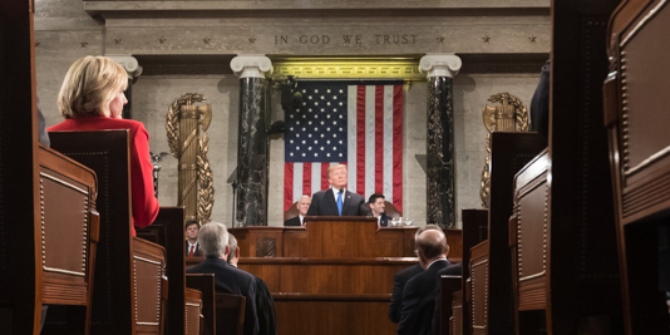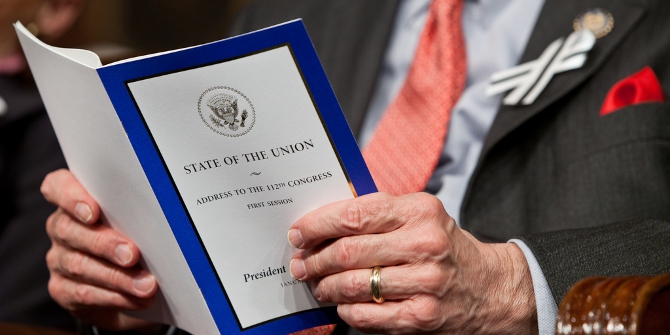

 Do new electoral brooms sweep clean the economic policies of the parties that went before? In new research that examines how incoming Western governments set their spending priorities, Derek A. Epp, John Lovett, and Frank R. Baumgartner find that budgets tend to be set with little regard to a government’s ideology, be it left or right. They argue that when setting budgets, incoming policymakers are constrained by social, economic and international realities that are largely beyond their control. This means that budgets are set consistently and inconsistently with what went before at roughly the same rate; left-wing parties do not necessarily favor “big government” nor to right parties always seek to reduce government spending.
Do new electoral brooms sweep clean the economic policies of the parties that went before? In new research that examines how incoming Western governments set their spending priorities, Derek A. Epp, John Lovett, and Frank R. Baumgartner find that budgets tend to be set with little regard to a government’s ideology, be it left or right. They argue that when setting budgets, incoming policymakers are constrained by social, economic and international realities that are largely beyond their control. This means that budgets are set consistently and inconsistently with what went before at roughly the same rate; left-wing parties do not necessarily favor “big government” nor to right parties always seek to reduce government spending.
Americans will head to the polls in November of 2014 to elect a new government, each voter doing their part to renew the political priorities of the nation. Subsequently, new legislators, and especially the new president, whoever they are, will hope to bring about the changes that motivated their electoral victories. This, after all, is what elections are all about. The implication – hammered home by pundits and campaigns that today cost billions of dollars – is that this change will lead to new ways of allocating fiscal resources, redirecting government spending to better solve social problems.
In new research, we investigate the ability of democratically elected governments to redirect spending to reflect their ideological priorities. We discover that governments, while they do indeed attempt to make such changes, face major constraints. On the whole, budgeting looks almost apolitical, in the sense that we cannot reliably distinguish the budgets of left- and right-wing governments. In fact, empirically, we find virtually no significant differences whatsoever.
At face value, this seems counterintuitive. Anyone paying attention to US politics knows that Republicans and Democrats have strongly divergent feelings about government spending. While this is especially clear in the current, highly polarized political climate, even with a broad historical perspective we know that conservatives and liberals have very different political priorities, and the same can said for left- and right-wing parties across Western Europe. Given these differences, we would naturally expect the spending habits of cross-ideological governments to be distinct.
One way to begin untangling the puzzle is to simply list some of the factors that might prevent political leaders from implementing an ideologically consistent budget: mandatory spending formulas, directives from the European Union, unforeseen natural or social crises, international conflict, economic turmoil, humanitarian crises, and so forth. Point being: the list is abundant. Any one of these factors puts pressure on political leaders to act and those actions come with budgetary consequences. In short, responsible governance may often preclude leaders from inflecting public budgets with their ideological prerogatives.
Consider the case of President Reagan and national defense. A major component of his presidential legacy are the dramatic increases in defense spending that took place during his first term – 1981 to 1984. Conventional wisdom is that right-wing parties place a particular emphasis on defense and the appropriations Reagan presides over certainly seem consistent with this logic. In only four years spending on defense grew by about $100 billion, or 20 percent. Clearly a case of ideologically consistent budgeting, our question is how often this type of appropriation actually takes place.
Figure 1 tracks total US budget appropriations toward national defense from 1947 to 2012, providing a new perspective on the changes from Reagan’s presidency. The light-grey shading indicates that a Republican was in the White House and from this vantage point there is no clear or consistent link between having a right-wing president and increasing spending on defense. To the contrary, many large increases take place during Democratic presidencies and the increases enacted by Reagan can be seen as the continuation of a trend that starts with President Carter. Furthermore, Reagan, during his second term makes relatively large decreases to the defense budget.
Figure 1 – Budget Appropriations for National Defense in the Modern Era, 1947-2012

The perspective gained from Figure 1 is important. Undoubtedly, ideologically consistent appropriations take place and, with a relatively limited focus, they are not particularly difficult to document. The concern that motivates our research is that by focusing so disproportionately on the changes that can be considered consistent, we lose sight of the budgetary process at large; a process where policy makers are tightly constrained by social, economic, and international realities that are largely outside their control.
Instead of focusing on any particular political administration or public policy, our approach is comprehensive. Looking in as much detail as available data allow at the US, the UK, Denmark, and France, and then systematically at 25 additional Organization for Economic Co-operation and Development (OCED) countries, and covering as much as sixty years of recent history, we look for patterns of change in national spending by left and right-wing parties, asking if shifts in spending can be explained by ideology.
A key analytic component is to classify budget categories by political party. The general idea is that left-wing parties are associated with health, welfare, and domestic social services, whereas right-wing parties emphasize social order, crime prevention, and national defense. (Of course, a number of budget categories are not typically associated with either a right- or left-wing ideology, and these we simply classify as “neutral.”)
After assigning the budget categories to parties it is easy to determine if there is any systematic pattern of spending consistent with ideology. A spending change is “consistent” if it increases spending more than the annual average to a budget category associated with the chief executive’s party, or if it increases less than the annual average to those categories associated with the rival party. “Inconsistent” budget changes would be (relative) cuts to one’s own party priorities or relatively great increases in those categories associated with the rival party. Finally, as some budget categories are deemed ideologically neutral, some changes may also be considered “neutral.”
Figure 2 shows the percentage of total appropriations that took place in each country across all available years that are consistent, inconsistent, or neutral. The figure is sorted by the percentage of consistent changes and clearly there are big differences across countries. Topping the list is Greece, where almost 40 percent of budgetary appropriations are ideologically consistent, contrasting with Korea, near the bottom of the list, where fewer than 20 percent of appropriations fall into this category. Most important, the bar for Total aggregates across all the preceding countries and shows that consistent and inconsistent changes, assessed collectively, occur at almost exactly the same rate. Finally, the last four bars show the distribution of changes for countries where budget data is most plentiful, but the additional data does nothing to distinguish the spending patterns of these countries from their OECD counterparts.
Figure 2 – Spending Consistency in OECD Countries

In all, our results show very little support for even the most basic of budgetary distinctions; for example, the idea that left-wing parties favor “big government” and right parties seek to reduce government spending finds no empirical support. Understanding public budgets as an expression of ideological priorities is probably misleading. Political parties are much more affected by the nature of the times and the particular policy challenges they happen to face during their time in office than they are able to force the implementation of what may well be their sincere ideologically-based preferences. Sometimes, governance means doing what you have to do rather than what you want to do.
This article is based on the paper ‘Partisan Priorities and Public Budgeting’, in Political Research Quarterly.
Featured image credit: Mayu Shimizu (Flickr, CC-BY-NC-SA-2.0)
Please read our comments policy before commenting
Note: This article gives the views of the author, and not the position of USApp– American Politics and Policy, nor of the London School of Economics.
Shortened URL for this post: http://bit.ly/1wUBxeL
______________________
 Derek A. Epp – University of North Carolina – Chapel Hill
Derek A. Epp – University of North Carolina – Chapel Hill
Derek Epp is a Ph.D. candidate in American Politics at the University of North Carolina, Chapel Hill. His research focuses on policy change, asking why some policies persist – remaining the status quo for decades – while others undergo frequent adjustments.
_
 John Lovett – University of North Carolina – Chapel Hill
John Lovett – University of North Carolina – Chapel Hill
John Lovett is a graduate student at the University of North Carolina-Chapel Hill, specializing in American Politics. His dissertation focuses on the notion of party branding and rebranding, and what conditions cause political parties to shift their issue priorities.
_
 Frank R. Baumgartner – University of North Carolina – Chapel Hill
Frank R. Baumgartner – University of North Carolina – Chapel Hill
Frank R. Baumgartner is the Richard J. Richardson Distinguished Professor of Political Science at the University of North Carolina at Chapel Hill. He is the co-author of Agendas and Instability in American Politics and other works.





